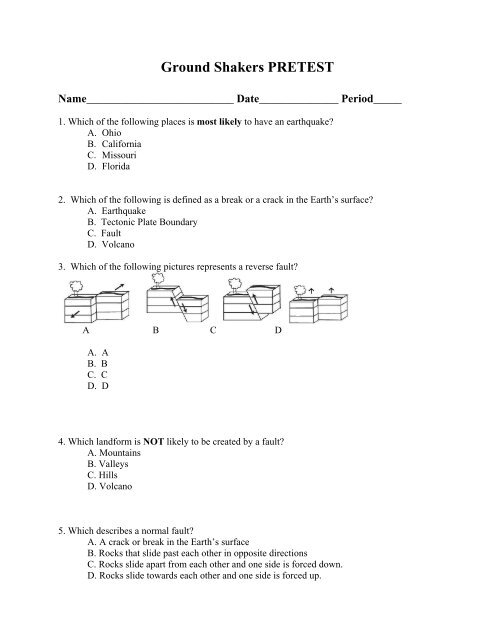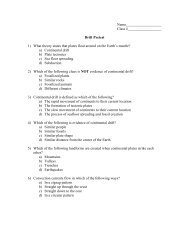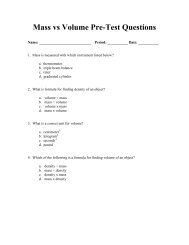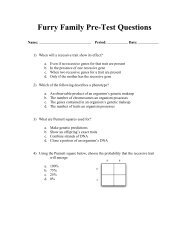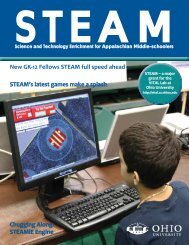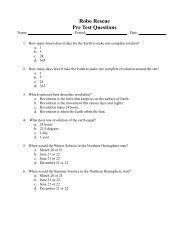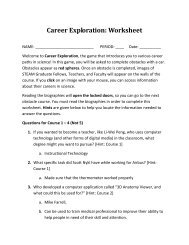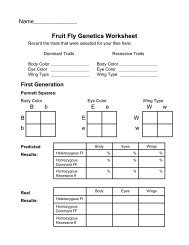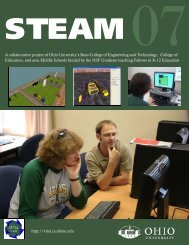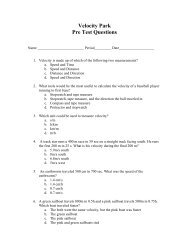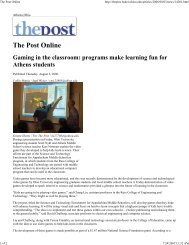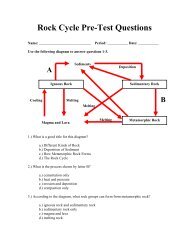Pre-test and Post Test Questions(pdf)
Pre-test and Post Test Questions(pdf)
Pre-test and Post Test Questions(pdf)
Create successful ePaper yourself
Turn your PDF publications into a flip-book with our unique Google optimized e-Paper software.
Ground Shakers PRETEST<br />
Name__________________________ Date______________ Period_____<br />
1. Which of the following places is most likely to have an earthquake<br />
A. Ohio<br />
B. California<br />
C. Missouri<br />
D. Florida<br />
2. Which of the following is defined as a break or a crack in the Earth’s surface<br />
A. Earthquake<br />
B. Tectonic Plate Boundary<br />
C. Fault<br />
D. Volcano<br />
3. Which of the following pictures represents a reverse fault<br />
A B C D<br />
A. A<br />
B. B<br />
C. C<br />
D. D<br />
4. Which l<strong>and</strong>form is NOT likely to be created by a fault<br />
A. Mountains<br />
B. Valleys<br />
C. Hills<br />
D. Volcano<br />
5. Which describes a normal fault<br />
A. A crack or break in the Earth’s surface<br />
B. Rocks that slide past each other in opposite directions<br />
C. Rocks slide apart from each other <strong>and</strong> one side is forced down.<br />
D. Rocks slide towards each other <strong>and</strong> one side is forced up.
6. Which describes a strike-slip fault<br />
A. A crack or break in the Earth’s surface<br />
B. Rocks that slide past each other in opposite directions<br />
C. Rocks slide towards each other <strong>and</strong> one side is forced down.<br />
D. Rocks slide towards each other <strong>and</strong> one side is forced up<br />
7. Which type of fault is also known as a thrust fault<br />
A. Normal<br />
B. Reverse<br />
C. Strike-Slip<br />
D. Transform<br />
8. Dr. Brown is st<strong>and</strong>ing on the east side of a fault line. She is looking west across the fault at a<br />
tree in a park. During an earthquake she observes the tree <strong>and</strong> the l<strong>and</strong> that it is sitting on moving<br />
downward. Use the information below to determine which type of fault Dr. Brown is observing.<br />
A. Normal<br />
B. Reverse<br />
C. Strike-Slip<br />
D. Transform<br />
9. Which state is least likely to have an earthquake of magnitude 8.2 or higher in the next 5<br />
years<br />
A. California<br />
B. Hawaii<br />
C. Alaska<br />
D. West Virginia
10. What type of force occurs when rocks are forced together<br />
A. Shear<br />
B. Compression<br />
C. Weak<br />
D. Tension
1. B<br />
2. C<br />
3. C<br />
4. D<br />
5. C<br />
6. B<br />
7. B<br />
8. B<br />
9. D<br />
10. B<br />
Ground Shakers <strong>Pre</strong><strong>test</strong> Answers
Ground Shakers <strong>Post</strong> <strong>Test</strong><br />
Name_________________________________________ Date_______________ Period____________<br />
1. If you wanted to move to a location that has few earthquakes, the best location would be:<br />
A. Ohio<br />
B. Washington<br />
C. Alaska<br />
D. California<br />
2. Which of the following pictures represents a strike-slip fault<br />
A B C D<br />
A. A<br />
B. B<br />
C. C<br />
D. D<br />
3. Which of the following pictures represents a normal fault<br />
A B C D<br />
A. A<br />
B. B<br />
C. C<br />
D. D<br />
4. Which area more often experiences high magnitude earthquakes<br />
A. Missouri<br />
B. Ohio<br />
C. Alaska<br />
D. West Virginia
5. Which of the following earthquake magnitudes is most likely to cause the most devastation in<br />
a populated area<br />
A. 7.9<br />
B. 13.1<br />
C. 5.4<br />
D. 9.2<br />
6. Which describes a reverse fault<br />
A. A crack or break in the Earth’s surface<br />
B. Rocks that slide past each other in opposite directions<br />
C. Rocks slide towards each other <strong>and</strong> one side is forced down.<br />
D. Rocks slide towards each other <strong>and</strong> one side is forced up<br />
7. Dr. Taylor is st<strong>and</strong>ing on the east side of a fault line. He is looking west across the fault at a<br />
barn. During an earthquake he observes the barn <strong>and</strong> the l<strong>and</strong> that it is sitting on moving<br />
downward. Use the information below to determine which type of fault Dr. Taylor is observing.<br />
A. Normal<br />
B. Reverse<br />
C. Strike-Slip<br />
D. Transform<br />
8. Dr. Johnson is st<strong>and</strong>ing on the north side of a fault line. He is looking south across the fault at<br />
a parking lot. During an earthquake he observes the parking lot <strong>and</strong> the l<strong>and</strong> that it is sitting on<br />
cracking <strong>and</strong> moving. Half of the parking is moving east <strong>and</strong> half of the parking lot is moving<br />
west. Which type of fault is Dr. Johnson observing<br />
A. Normal<br />
B. Reverse<br />
C. Strike-Slip<br />
D. Transform<br />
9. Which state is most likely to have an earthquake of magnitude 6.5 or higher in the next 5<br />
years<br />
A. California<br />
B. West Virginia<br />
C. Ohio<br />
D. Missouri<br />
10. When rocks are pulled apart, what is the force called
A. Shear<br />
B. Compression<br />
C. Weak<br />
D. Tension
1. A<br />
2. A<br />
3. B<br />
4. C<br />
5. D<br />
6. D<br />
7. B<br />
8. C<br />
9. A<br />
10. D<br />
Ground Shakers <strong>Post</strong> <strong>Test</strong> Answers


